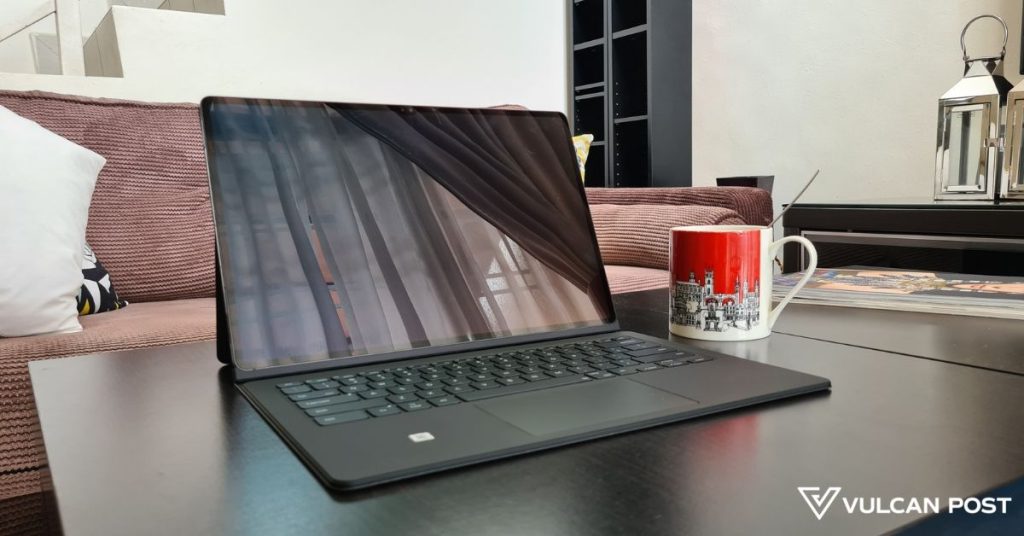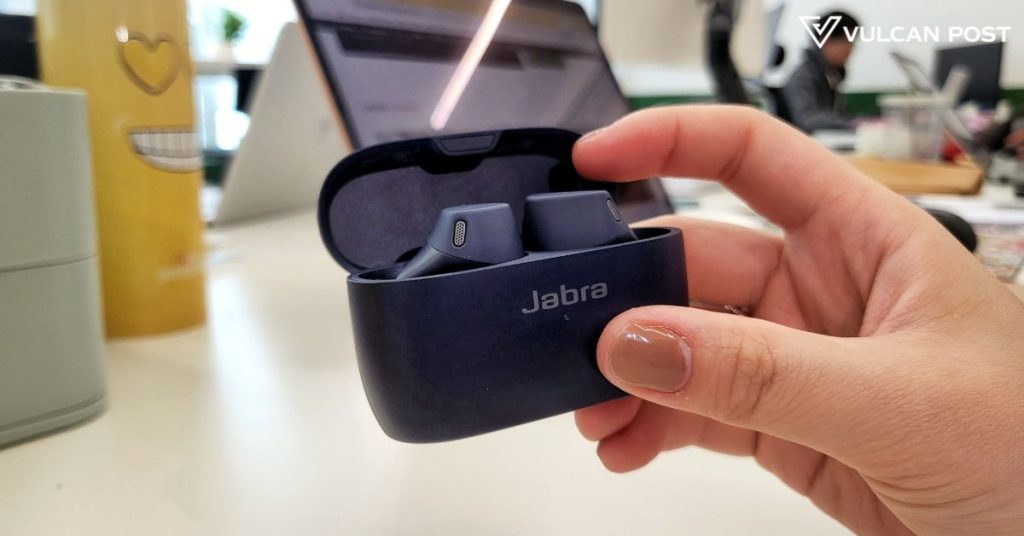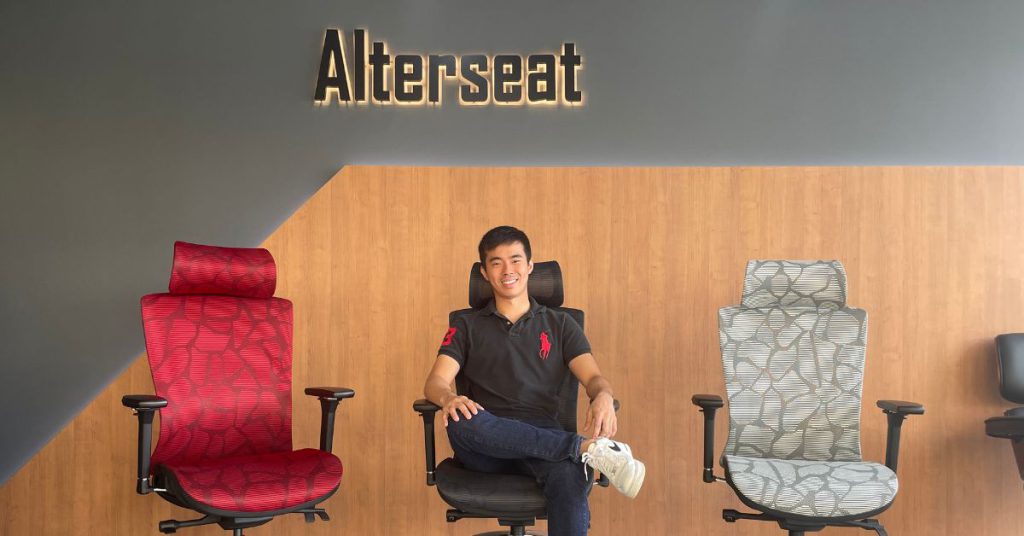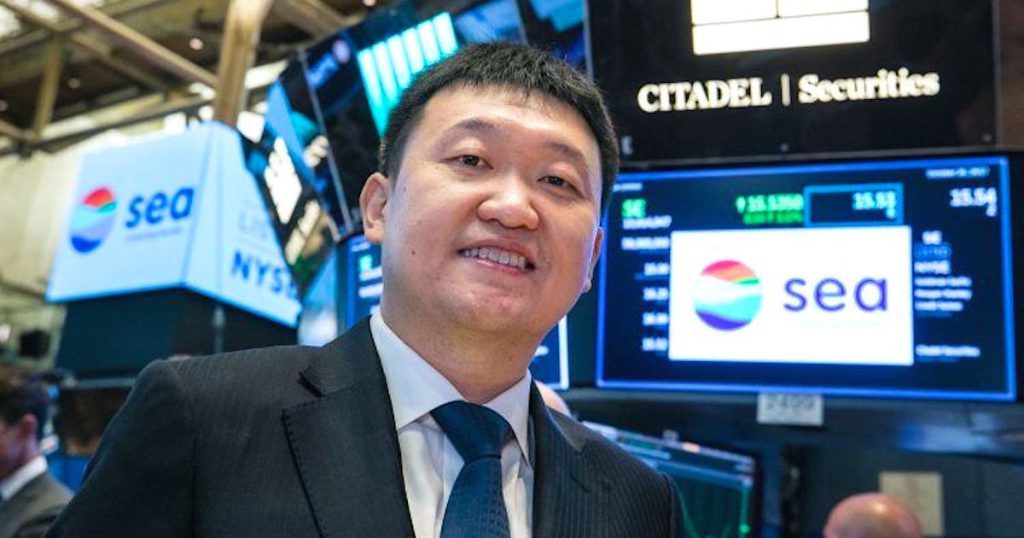Samsung convinced me that a tablet CAN be a laptop alternative with the Galaxy Tab S8 Ultra

Let me preface this article by saying that the Samsung Galaxy Tab S8 Ultra is big. At 14.6 inches, it’s bigger than the usual 13-inch laptop I lug around.
Despite that, it’s lighter weight-wise at under 730g, but you’d still notice the weight when you carry it around in your hand or a backpack.
The tablet itself is physically a thing of beauty: thin and sleek with a matte finish. There’s only one colour available, Graphite.
In my eyes, the dark-greyish colourway is reminiscent of the duller silvery colourway of most laptops, further emphasising Samsung’s intention with the Tab S8 Ultra: to make it a laptop alternative.
But first, what’s it like as a tablet?
Your standard tablet, but better
Honestly, my experience of using the Tab S8 Ultra as a tablet was similar to my experience using other Samsung tablets in the past.
I’m not someone who has much use for tablets in general, always finding them to be an odd in-between in terms of size and use when compared to phones and laptops.
Now, the huge Tab S8 Ultra leans more towards the laptop experience, which I appreciate much better, but it still has great functionality as a tablet.
Its Super AMOLED HDR10+ display is 1,848 x 2,960 pixels and is crisp by most standards, enough to satisfy your movie-binging and gaming needs (although its large size makes it a little tricky for most mobile games).
Switch between a standard 60Hz or high 120Hz rate depending on what you’re doing. It’d be nice to see an adaptive refresh rate someday in order to better preserve battery life without sacrificing user experience.

In terms of audio, the stereo speakers along the vertical (shorter) edge of the tablet produce sounds that are loud and clear, enough to easily fill a room.
Compared to my other experiences using older Samsung tablets though, I can say the Tab S8 Ultra offers a much better tablet experience, simply because it’s larger and more capable (but points might have to be docked for portability).
In my review of the Tab S7 Plus, I mentioned how it still offered a largely tablet experience, plus some productivity thanks to DeX and the book cover keyboard. Ultimately though, I concluded that it would have been unfair to compare it to an actual laptop.
This is where the Tab S8 Ultra differs.
A laptop experience, but also better (maybe?)
Meant to be used more like a laptop, Samsung even thoughtfully put the notch along the long edge of the Tab S8 Ultra, which means it doesn’t hinder your work when using the tablet horizontally.

Housed in the notch is an honestly amazing front camera that would be great for video calls. The back camera isn’t anything to scoff at either, able to zoom up to 8x with clarity.
With the book cover keyboard, the Tab S8 Ultra transforms into a versatile device, going beyond most standard tablet or laptop experiences.
Since typing using the on-screen keyboard can be tiring and slow due to the large screen size, I really liked how I could use the keyboard and touchscreen interchangeably.
This meant I could adjust a YouTube video’s settings by touching the screen and type out a comment with the book cover keyboard right after without changing settings.
In that sense, the book cover keyboard brings out the tablet’s best functionality. It has some weight of its own, but is a must-have (and must-use) if you’re bringing the Tab S8 Ultra around.
Not only is it a sleek, detachable keyboard, but it’s also both a stand for your tablet and a protective casing in one. The keyboard is comfortable enough to use for a whole day of work, while the trackpad is decent. A mouse would make for a more convenient option.

I can’t talk about productivity and a laptop experience on the Tab S8 Ultra without mentioning DeX, Samsung’s software platform that extends a Samsung tablet (or smartphone) into a desktop computing experience.

When I activate it, I get a more traditional and familiar laptop experience, such as resizable multi-window views with different apps open for easier multitasking, using Alt + Tab to quickly switch between windows, and more.
It takes next to no time to set DeX up, and there’s no learning curve to familiarise yourself with it. In fact, this article was written on the Tab S8 Ultra itself using DeX.
Once I’m done with work, I can just turn off DeX and detach the book cover keyboard, and the Tab S8 Ultra goes back to being a tablet.
Something to note if you’re using the book cover keyboard is that the Tab S8 Ultra is quite top-heavy and prone to toppling if you’re not careful, so it’s best used on a firm and stable surface.
VP Verdict
The Tab S8 Ultra comes with an S Pen included alongside the book cover keyboard. I found myself underutilising it since I’m no digital artist, nor do I find myself needing the convert-handwriting-to-text function in my day-to-day routine.
In a creativity-focused article though, I will be reviewing the S Pen and its features more in-depth.
Back to the tablet itself, I can say with confidence that the RM5,899 Tab S8 Ultra is unlike any other tablet Samsung has released so far.
The only area where it might potentially lose points as a tablet is in its portability, but it’s an easy trade-off for the powerhouse that the Tab S8 Ultra is, especially for those who want a tablet and an on-the-go laptop experience simultaneously.
It’s a great (and large) tablet experience with capabilities that make it a viable laptop alternative, and I’m looking forward to seeing what else Samsung can add to its next generation of tablets.
| Pros | Cons |
|---|---|
| Large and clear display for work and play | Slightly heavy to carry around |
| Great functionality especially with DeX and the included book cover keyboard | Can easily topple on uneven or unstable surfaces |
| A laptop and tablet experience in one device |
VP Verdict is a series where we personally try and test out products, services, fads, and apps. Want to suggest something else for us to try? Leave a comment here or send the suggestion to our Facebook page.
Also Read: With 350+ cryptocurrencies available on Poloniex, here are 3 features it brings to the scene
S’pore F&B tech startup Oddle raises US$5M to fuel product development, regional expansion

Singapore-headquartered F&B technology company

Founded in 2014 as a white-labelled e-commerce provider for F&B operators, Oddle is now a holistic hospitality powerhouse that has partnered over 5,000 restaurants, cafes, bars, and hotels across the region.
Oddle fills the gap in the F&B industry by helping F&B owners improve and optimise their operations through smart data and meaningful engagement.
Its “Always Restaurant First” philosophy differentiates itself from its competitors, as it aims to give each F&B operator maximum yield at minimal costs.
Within two years, Oddle has helped its restaurant partners grow their Gross Merchandise Volume (GMV) from S$30 million in 2019, to S$200 million in 2021.
Oddle themselves saw over 17 times increase in revenue over the same period, and is now “capital-efficient”, according to the company.
“Oddle makes money only when its partners are successful in increasing traffic and revenue. This ensures sustainability for both the company and its partners and is reflected in the company’s recent performance. The new products that Oddle is launching will further strengthen their offering as a key enabler of the F&B ecosystem,” said Seow Kiat Wang, General Partner of Altara Ventures.
Through their O2O ecosystem, Oddle is continuously building for the future of the restaurant industry and is now at a hypergrowth stage.
Featured Image Credit: Oddle
Also Read: No longer S’pore’s richest man: Sea co-founder Forrest Li lost almost US$18B in stock crash
The versatile Jabra Elite 4 Active make for great workout & chill-out buds on a budget

My go-to pair of true-wireless (TW) earbuds lately has been the Jabra Elite 7 Pro, the brand’s most premium pair of TW earbuds in 2021. In fact, it was this pair of earbuds that convinced me that active noise cancellation (ANC) was the way forward.
The Jabra Elite 4 Active is part of the brand’s 2022 lineup for TW earbuds.
Going into this review, I had high hopes, having never been disappointed by Jabra’s audio devices thus far. Safe to say, the Elite 4 Active met my expectations.
Out of the box
Like Jabra’s predecessors, the box came with the earbuds in Navy, three different EarGels (earbud tips), a USB-A to USB-C charging cable, and a warning and declarations booklet. There is no user manual is included, but you can find it in Jabra’s Sound+ app.

The shape of the Elite 4 Active’s case is most similar in size to the Jabra Elite 85t, but behaves more closely to the Jabra Elite 3. The LED to display the battery status is sensibly positioned on the front, as opposed to older Jabra earbud cases where it was on the back.
Charging was straightforward and took a rough two hours to bring it to a full charge that promises seven hours of uninterrupted playtime, and 28 hours with its charging case. I’ve only had to bring the case’s battery up to 100% when I first received it, and I haven’t needed to do so after two weeks of daily usage (averaging about two hours/day).
The earbuds had to of course be charged more often by being placed in the case. Jabra claims that it can fast-charge up to one hour of use in just 10 minutes. From my testing, this has been accurate.

Because the case is pill-shaped and taller in height, its lid can be easily flipped open and closed with one hand, fitting for those who are a little fidgety.
Functionality-wise, nothing much has changed with the Elite 4 Active. Button controls are still tangible to easily adjust volumes of your music, trigger voice commands, or switch between ANC and HearThrough.
How do they sound?
In line with most of Jabra’s TW earbuds, the Jabra Elite 4 Active can be customised through the Sound+ app, which automatically connects when you take the earbuds out of their case.
Here, you can adjust the equalisers, find your earbuds when they’re missing, view the battery percentage, and update the device.
Like the Elite 3 though, there’s no Moments feature with the Elite 4 Active to personalise your music’s settings depending on your surroundings.
Listening to my usual playlist of musicals and pop music, the bass sounded rich and well-controlled, and there was a good level of clarity in the trebles and vocals. I mostly kept the preset EQ at the Neutral setting since I appreciate well-balanced levels.

Although, I can’t sing the same praises about this pair’s music quality as I did for the Elite 7 Pro. It may be due to the fact that while the Elite 4 Active does come with ANC functions, they don’t block out external noises as well as the Elite 7 Pro does.
Other than the Elite 4 Active’s lower price point, perhaps Jabra has a practical reason for making it so.
This model is mainly marketed as a workout companion. For joggers and cyclers using the sidewalks or main roads, it is important for them to be able to hear their surroundings from vehicles on the streets.
When it comes to calls, the Elite 4 Active boasts four-microphone call technology, protected by a mesh covering for added wind noise protection. Testing this, my caller reported that they could hear me loud and clear, even with the wind from a wall-mounted fan blowing close by, and some music playing next to me.
Fit for fitness?
As mentioned above, this pair of TW earbuds are designed for workouts, claiming to have a secure active fit with an ergonomic, wing-free design. To add, the Elite 4 Active comes with certain features that are fitting for active habits.
Sporting an IP57 water-resistance rating, it’ll keep the earbuds well protected from sweat and rain.
Running is the worst form of exercise for me, so I won’t be judging the earbuds’ fit based on this. But since graduating from home workouts amidst lockdowns, I’ve been playing badminton frequently, and also went for a couple of golf sessions with friends.
In terms of the Elite 4 Active’s fit, it wasn’t the easiest to comfortably secure the earbuds in my small ears, even when using the smallest EarGels (it may be just me). This problem never came up with the previous models I’ve reviewed since I didn’t use the other models to work out with, just mainly for listening to my media.
While the Elite 4 Active were able to stay put in my ear canals when playing golf (the driving range kind), I can’t say the same about them for badminton games since I hopped around so much (and needed to clearly hear my doubles partner scream instructions at me).
Verdict
There is a mono-mode present on the Elite 4 Active. It’s where you can use just one earbud to watch videos while lying down, keeping the other earbud safe in the case.

It’s a shame there’s no auto-pause function when you remove the buds from your ear, but for an RM579 pair of Jabra TW earbuds, it’s a small sacrifice rather than a deal-breaker.
Overall, I liked my experience with the Jabra Elite 4 Active for its clear, well-balanced audio, call quality, and ANC. To add, the long-lasting battery was dependable as well because charging my earbuds is something I neglect.
The earbuds’ connectivity range was also reliable. I could walk around the house, far from my phone, and still have music playing in my ears.
| Pros | Cons |
|---|---|
| Crisp, well-balanced sound quality | ANC leaves more to be desired |
| Great call quality even with background noise | No media auto-pause when one earbud is removed |
| Fully waterproof | |
| Dependable battery life |
VP Verdict is a series where we personally try and test out products, services, fads, and apps. Want to suggest something else for us to try? Leave a comment here or send the suggestion to our Facebook page.
Also Read: 5 ways this crypto platform simplifies the investment process for beginners & pros
Altering how M’sians sit, local ergonomic furniture brand has grown to open a 2nd showroom

In 2020, Vulcan Post spoke to Benedick Chen, founder and CEO of Alterseat Malaysia, a local ergonomic chair brand. Back then, they were just an e-commerce business, but they have since grown their offline presence with two storefronts and two warehouses.
I recently visited the newest showroom in Uptown Damansara and sat down (pun intended) with the other half of the founding duo, Shaun Tan, to learn about Alterseat’s growth over the past years.
Walking into the store, I was greeted by a row of Alterseat chairs and a sales representative who was already tending to another party. I was soon joined by Shaun, who gave me a tour of the space.
Their first store was in Bukit Jalil, where the company’s office and warehouses are located. After noticing that some customers outside of the Kuala Lumpur area were unwilling to travel into the city due to traffic, this new spot was chosen to tap into the Petaling Jaya market.

“We studied our analytics and looked at our insights,” Shaun explained. “We get a lot of enquiries from the PJ area. And I would say the Uptown and Damansara area specifically, the GDP per capita is a little higher than other districts, so that’s why we opened in Uptown.”
It’s a fairly minimalistic space, and there will be a second floor soon to feature an office concept for bulk purchasers or consumers who want to purchase an entire office setup.
Shop Alterseat’s furniture on VP Label at an exclusive price now:
[iframe_vp_product src="https://vulcanpost.com/label/my/embed-products/embed-alterseat/" id="iframe1"]
Amping up offline efforts
Alterseat’s decision to invest in another physical store could be seen as a departure from the new normal, considering how global e-commerce growth was boosted during the pandemic. But as Malaysia reopens, Shaun believes shopping habits have actually shifted offline.
To back up his statement, he shared that 50-60% of Alterseat’s sales now come from the physical outlets.
In the Bukit Jalil location, Shaun reported an 80-90% conversion rate, meaning most customers will actually leave with an Alterseat product. While that number is already high, Shaun expects to see a greater number from the Uptown location due to increased foot traffic.

True enough, in the one plus hour I was there, I saw two groups of walk-in customers, and a passerby who peered into the shop curiously.
Despite the significant growth of their offline presence, the team have not neglected their online following either, and utilise influencer marketing to their benefit.
Altering the market
Growth comes with change, and though they used to offer customisation, Alterseat realised it wasn’t the most economical move. The service increased costs and time, making it difficult for the business to scale.
Instead, making specific products to suit most customers’ needs and expanding their range of products for more variety appeared to be the right way forward.
Their B2B traction even grew. During the pandemic, companies like Digi, Celcom, DECATHLON, and Maxis made bulk orders so their staff members could work comfortably from home.
Now that employees are returning to the office, Alterseat has noticed SMEs buying 20 to 50 units to furnish their offices too. Larger fast-moving consumer goods companies have also ordered thousands of chairs for their employees, Shaun shared.

“We don’t go knocking on [businesses’] doors, we just create really good chairs, and we sell to normal consumers like you and me,” Shaun said. “And these people so happen to be working in HR or recruiting companies or they’re the CEOs of other companies.”
To up the ante on the B2B segment though, the team is planning to engage with salespeople to reach out to businesses. LinkedIn Marketing might also be in the pipeline, as Shaun believes many leaders and decision-makers will be accessible there.
On top of expanding their range of chairs, Alterseat has introduced new smart desks, which serve as an add-on to the chairs.
While things have certainly been evolving at Aterseat, some things remain the same—namely, the core message.
“Our value proposition is still providing consumers high quality and premium chairs at an affordable rate,” Shaun affirmed. “I believe the moment companies sway from their core values, that’s when everything starts to go downhill.”
The challenge of growing
Shaun revealed that in the last accounting year, Alterseat brought in close to RM7 million in revenue, a significant increase in their financials compared to previous years.
However, there have been internal challenges over the past year too, specifically with hiring the right people. In the end, they prioritised talents with the right personalities and attitudes over experienced ones, and simply provided training.
“Over the course of two years, we managed to scale from a two-man team to almost 15 people full-time,” Shaun shared. The number goes up to around 30 when counting the logistics team and subcontractors.

Another challenge is something we’re familiar with—inflation. The cost of supplies has gone up, and it’s also hard for end consumers to invest hundreds, if not thousands, of dollars into a chair.
“When [the inflation] started to snowball, we saw a slight dip in our quarter-to-quarter sales, so we quickly pivoted to things like installment plans,” Shaun shared.
Staying in the hot seat
Shaun’s entrepreneurial skills certainly help keep the business running smoothly, though he believes it’s ultimately the product that really gives Alterseat its value. He shared how customers have told him that the chairs changed their lives.
“Can you imagine?” he laughed. “How can a chair change a person’s life, right?”
Yet, Shaun understands the sentiment. He used to buy cheap gaming chairs online, but they caused backaches and butt pains. He ended up going to a chiropractor, whose services cost more than a few Alterseat chairs. Hence, he knows first-hand how important it is to create products that enhance people’s lives.

While positive comments about Alterseat are aplenty, there are still lots of competitors in the market, including big players such as AM Office, Office Pro, and Apex. As such, Alterseat’s goal of becoming the go-to brand for ergonomic chairs in Malaysia has not been reached yet.
Still, the company is striving to capture more market share through its offline presence. Over the next couple of years, Alterseat aims to launch more stores across Malaysia. Shaun listed Kuala Lumpur, Selangor, Ipoh, Penang, Sabah, and Sarawak as target locations.
Beyond that, he also has his eyes set on APEC countries such as Singapore, Thailand, and Australia.
“On the online route, we plan to be omnipresent,” he added. “That means being present and active on every single platform.”
Expect to see Alterseat across platforms such as TikTok, Facebook, Instagram, YouTube, and even Xiaohongshu. But if you’re in the Klang Valley, maybe hit up the Bukit Jalil or Uptown Damansara locations if you get the chance, and get a feel for the seats yourself.
Shop Alterseat’s furniture on VP Label at an exclusive price now:
[iframe_vp_product src="https://vulcanpost.com/label/my/embed-products/embed-alterseat/" id="iframe1"]
Also Read: 5 ways this crypto platform simplifies the investment process for beginners & pros
No longer S’pore’s richest man: Sea co-founder Forrest Li lost almost US$18B in stock crash

In September last year, Forrest Li, the co-founder of Sea — the parent company of Shopee — overtook Li Xiting to become Singapore’s richest man with a net worth of US$20.2 billion.
He retained that status till just a few months ago with his US$22 billion fortune. Now, he no longer makes the cut to be the top 500 richest people in the world.
According to the Bloomberg Billionaires Index, his net worth is now valued at only US$4.7 billion.
He has emerged as one of the biggest losers from a huge market crash. Additionally, the shutdown of its main e-commerce operation in India and disappointing earnings have tanked the company’s American depository receipts more than 80 per cent from a peak in October.
At one point, Sea was touted as Southeast Asia’s most valuable company, as it deepens its foray in fintech beyond gaming and e-commerce.

The upcoming year will pose several challenges for the company. Like other tech companies that soared when the COVID-19 pandemic began, Sea is now facing difficulties due to an increase in interest rates as well as the tensions due to the war in Ukraine.
Sea is also facing renewed competition from rival businesses, including Alibaba, and more people are shifting from online to offline purchases as pandemic restrictions are eased.
Sea is scheduled to report its first-quarter earnings soon, and is expected to post a record loss of more than US$740 million, according to the average analyst estimate compiled by Bloomberg.
Sea’s net loss had already widened in the final three months of last year as the firm aggressively expanded.
Sea’s valuation collapse prompted Li to reach out to his employees earlier in March. In a 900-word internal memo, he told them not to fear and that while the drop is painful, “this is short-term pain that we have to endure to truly maximise our long-term potential”.
Many tech entrepreneurs have also lost their fortunes
Besides Li, many tech entrepreneurs who saw their wealth rise on the back of the pandemic-induced growth are being hit hard by the market selloff.
Eric Yuan, chief executive officer of Zoom Video Communications, has lost US$4.4 billion of wealth this year, while the fortune of Amazon’s Jeff Bezos, the world’s second-richest person, is down almost US$58 billion.

The company’s other two co-founders are also not spared. Gang Ye has lost US$4.3 billion in wealth this year, while David Chen is no longer a billionaire.
Previously, all three of the founders, who hail from China, were featured on the top half of Forbes’ Singapore’s Richest 2021 list.
Featured Image Credit: Sea Ltd
Also Read: S’pore startup YouTrip finds new opportunities amid COVID-19, now enters B2B payments space



